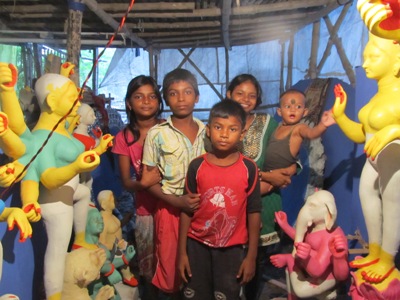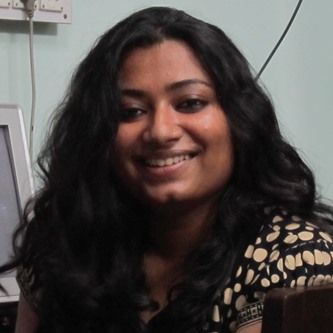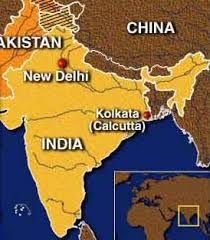Voices from the Sylff Community
Aug 21, 2013
Voicing Violence: Constructing Meaning from Narratives by Children in Red-Light Districts of South Kolkata
Anindita Roy received her Sylff fellowship from Jadavpur University in India in 2012 and conducted research in the United Kingdom using a Sylff Research Abroad grant from April to June 2013. In this article, she writes of children’s psychological development under adverse conditions in India, based on an analysis conducted in the UK of the field data she gathered over a year of research in Kolkata, India.
* * *
Interests drive passion. Sometimes, they also help to shape paths that lead one to journeys of exploration. In my case, an interest in children and their development have led me into landscapes of the mind and how it constructs meaning. Specifically, mine has been an academic endeavor to understand the meaning-making process and its relation to identity formation, especially in children living in adverse environments. My research was carried out in two red-light districts of Southern Kolkata, and its participants were girls and boys aged between 8 and 14. During this year-long research, I was often asked about my choice of research site: “But, why the red-light district?”
Empowering Children in Economically Deprived Areas
Through a community involvement project I undertook at Jadavpur University, I had the opportunity to access the red-light neighborhoods of Kalighat and Khidderpore (which are the sites I chose in my research for a master of philosophy degree). The project was designed to empower children in economically and socially deprived areas whose needs and concerns, it was felt, were largely under-represented and often misrepresented. The participants of this project were trained to become radio reporters so they could express themselves on the platform of a community radio station located on the Jadavpur University campus.
There was one young and promising participant from Kalighat who suddenly stopped attending the training sessions after an enthusiastic involvement over half a year. We were informed by the institution that introduced us to the children in this sensitive area that the participant had left the city and returned to the village and would no longer be able to join the project. It was some weeks later that this participant was seen (by several members of our project) standing with a couple of young girls on the lanes of Kalighat, trying to get clients. We assumed from what we saw that the child, who was still a minor, had become part of the flesh trade. Over the course of the project, a few more children left to “go back to their villages.” (This is not to suggest, though, that they, too, entered the same profession, for unlike the first participant, they were never seen again.) I was less troubled about the truth of what we were told and why than about the kinds of thoughts that must have run through the children’s minds as they made their choices.
How did they make their choices? This was my chief concern: How do these children perceive their lives and the environments in which they live, as well as the meaning and consequences of the choices they make? The current research is part of an organic work in progress—an attempt to understand some of the questions that had seized my mind a long time ago.
Narratives of Abuse, Violence, and Suffering
Coming back to this work, made possible when my proposal was selected for a Sylff Research Abroad award, gave me an opportunity to carry out advanced research in the United Kingdom, where I was guided by scientists and teachers in the fields of psychology and childhood studies. A significant objective of my SRA project was to identify patterns from narratives created by children to understand their psychological development. For my fieldwork, participants were asked to take part in semi-structured interviews and story-telling sessions based on pictures that were presented to them.
Whether in reconstructing narratives from memories of lived experiences or in creating new tales for characters in their stories, the participants selected and conveyed narratives that were indicative of abuse, violence, and suffering. This repetition of certain information emanating from the participants’ memories defined and described their narratives. Understanding such field texts required a co-construction process based on familiarity with the field of research. Understanding violence starts from reading between the lines of what appears on tape in interviews and stories. The facts that are explicitly stated, though, helped me to categorize various expressions of violence. These categories may help lend meaning to the violence the participants recreate for their characters and elucidate the way they understand it in their own experiences.
Violence renders characters helpless. They protest but without support often succumb to the adversities in their environment. It entraps them:
“He started to hit his son, saying that he should work. The son protested, since his sister was studying, and said that he wanted to study too. He did not want to go to work. But the father hits him again and forces him to work. The son is frustrated and sad. He isn’t being allowed to do what he likes. He is not being allowed to gain an education or obtain a sense of security. The parents are forcing the son to do what they want. The boy weeps and cannot communicate.” (Participant A, story, excerpt)
The voice of the protestor surfaces but is silenced by authority—the father in this case. The “son is frustrated and sad” but has no resources that might extend support to him. In another story, the narrator finds his character equally distressed.
“One day, the boy was sent home from school for not being able to pay the fees. He went to his father and requested that he pay the fees. The father said that he had no money and that all the money was gone. The boy had to leave school. The boy requested that the father take up a job and help support the family. The father slapped the boy and said, “Why should I work? You will work.” And he sent the boy to a brick factory. The boy got 1000 or 2000 rupees a month. The father would snatch all the money from the boy and not even let him eat properly. The father would eat first and then give the leftovers to the son. The son was falling ill from not eating.” (Participant B, story, excerpt)
Death of Aspirations
In the face of discouragement, constant pressure, and abuse, the protestor’s voice is silenced. There is not only a metaphorical annihilation in terms of communication but also a physical extinction in certain cases. This reiterates the sense of seclusion, isolation, and neglect that the participants often mention in the process of their interviews, too. Not many are willing to listen or interact, and possibly the protestor may stop protesting altogether.
In the case of the first example, the narrator ends the story by saying, “He cries and declares finally that he will work, for his sister’s sake. He goes to work.” (Participant A, interview, excerpt). The voice of the character of the child in the story—the protestor—is dead. Their voice is possibly just as dead as their aspirations to study. The lack of voice eventually becomes the loss of voice.
“My parents have a fight between themselves. My mother works even in the night. My father comes in the morning and fights with her for money. He gambles and is unemployed. He comes home, eats, gambles, snatches money from my mother, and goes away. He does not let my mother sleep and hits her. I have tried so much to explain to him, but he will only beat me up. When I was seven, he hit my mother so badly that her skull cracked and was bleeding. I tried to stop him, but he slapped me so hard that I fear him from that day.” (Participant B, interview, excerpt)
Reconstructing the experience, the participant mentions the atrocities and the efforts made to check them by trying to convince the father against torturing the mother but is beaten up in response. It seems that there is no one to whom the participant can reach out for support, none that is consciously available in the participant’s mind at least. In the lack of support and a sense of helplessness, there arises the emotion of fear, which eventually swallows the participant’s voice in expression.
Perpetuation of Violence

Children celebrating Durga Puja, the biggest festival of West Bengal, where the author conducted interviews for her research
In some cases, the expression of violence as a ‘should’ is also prevalent. This norm is in keeping with a social code of disciplining the child, for example: “If I were to choose between the father and the son, I would want to play the role of the father. I will have to become a father once I get married. I am hitting the boy because he doesn’t listen to me. I asked him to get a bucket from the market but he ran away.” (Participant C, story, excerpt)
It is as if, just like the character who feels he “will have to become a father” once he gets married, he will “have to” hit his children to help them learn. Another participant tells in a story, “If I were to play the role of the father, I would hit my son, too. I would hit him, if there is a need, to get things done. Sometimes it is important to hit, or else children become disobedient.”
Very few cases look at violence through the lens of characters that resort to violence for the sake of it or for the fun of it. “There are some people who only need a trivial reason to pick up fights. They are always ready to fight.” (Participant D, interview, excerpt) The readiness to fight seems to be reason enough for a fight as well. Another participant says in a story, “And this older boy is now hitting the younger boy. The older boy just feels like it. The reason could be anything—he just feels like beating up this boy, or he may just feel like creating trouble. If he creates trouble, he will have fun.” Few in number, but qualitatively significant, is the concept of characters deriving pleasure from the troubles they create (usually for others). “We might wonder why the man should hit the boy at all; but the man might be enjoying this act of hitting a boy.” (Participant E, story, excerpt).
Succumbing to violence, whether as oppressor or oppressed, is the dominant pattern in most plots. The characters suffer physically through beatings, psychologically through trauma, and emotionally through frustration and anxiety. The characters’ sufferings could be reflective of the participants’ own suffering, including from the inability to choose more positive alternatives, even in the realm of imagination. I do not present these patterns as predictions about individual development or social adaptation. I only propose that these constructions be regarded as voices that demand understanding and keen attention. There must be an attempt to understand what the narratives mean to the ones making them. In the case of my research, an attempt has been made to understand the meaning of violence as a first step in understanding the environments within which these children live and grow.
Is Schooling Synonymous with Learning?
In the recent past, the field of child development has been focusing on approaches to promote sustainable growth. While social theories and large-scale data have been constructively prevalent in India, so far, very little attention has been paid to children’s development from the perspective of understanding the child’s mind, emotions, and imagination. Well-meaning programs and policies have been formulated to accelerate growth in adverse conditions. In education, for example, programs have been introduced aimed at improving learning, such as a mid-day meal and free schooling until a certain age to promote education, especially for families in economically deprived conditions.
However, children may not necessarily equate schooling with learning. For example, in the course of data collection, some of my participants said that they would like to go to school, knowing that education is important, but also admitted that they are more interested in either the mid-day meal or in playing on the large school grounds from a lack of space in their own homes or their neighborhoods. The mid-day meal might thus help improve attendance at school but may not help improve learning. If school for these children means food and a place to play, then education will not be their first synonym for school. This is the dimension I hope to elucidate.
Such meanings will become clearer and more audible when the children are allowed to express and speak their minds. But sometimes, their realities are too difficult to share, even if they want to share them. In other parts of my research I have, therefore, analyzed the techniques of narrative construction as a means of expression and as clues to the understanding of the child. Henceforth, it would be interesting to explore and analyze the realm of the imagination and the use of it by children to renegotiate with their realities (or, maybe, to chance upon a completely new understanding).

